�
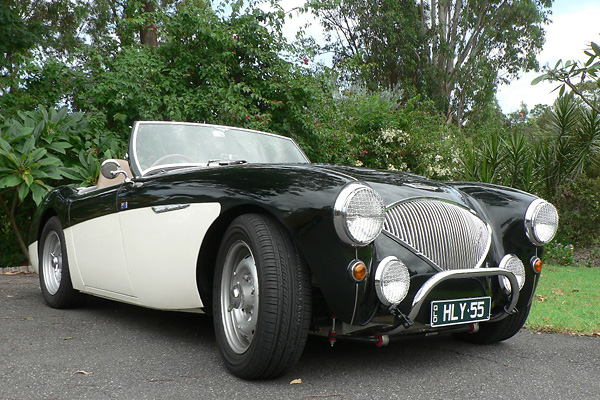 �
�
Peter Linn's Holden V6 Powered 1955 Austin Healey 100
� as published in BritishV8 Magazine, Volume XVIII Issue 1, December 2011�� Owner: Peter Linn
� � City: Brisbane, Queensland, Australia
� Model: 1955 Austin Healey 100
� Engine: Holden 3800cc V6
� Conversion performed by: Bob Wittred and Peter Linn�
�
Peter Linn Tells the Story of "The Holden Healey"
��
Austin Healey 100 chassis number BN1-223926 rolled out of Austin's Longbridge factory�
on February 10, 1955. The car was Healey blue with blue trim. It was dispatched to�
UK Motors in Brisbane.�
�
In the mid-1980s, Queenslander Bob Whittred came across the remains of the car on a�
farm near Ballina New South Wales, where it had sat for many years following an accident�
in which the front left corner was extensively damaged. The drivetrain and most of the�
running gear were long gone. �
�
Bob paid $450.00 (Australian) for the sad remains, and commenced what by any standards�
was a mammoth task of restoration. This involved replacing the front half of the chassis�
rails, crossmembers, much of the body sub-frame and repair or replacement of most of the�
outer body panels. BN2 rear guards were fitted, and the car was prepared for final panel�
work and paint. Bob found a Wolseley 6/110 sedan parts car, and used its front suspension�
including disc brakes with booster, and its rear axle with 3.54 differential. (These�
parts are all very similar to later Austin Healey 3000 running gear.) For an engine,�
Bob initially planned to install a Rover 3.5L V8, but he found this to be a tight fit,�
so instead sourced a 40,000km V6 from a Series 1 Holden Commodore. Like the Rover V8,�
Holden's "3800" engine (which is similar to Buick's 3800 ninety-degree, iron-block V6,�
except assembled in Australia,) is closely derived from Buick's 215 cubic inch aluminum�
V8, first introduced in 1961. The engine came with a 4 speed automatic gearbox.�
�
The Holden motor was a good fit. It's smaller and lighter than the original Austin engine�
and it was easily mounted lower and further back in the chassis. It produces 165 bhp in�
standard tune.�
�
The restoration stalled in the mid-'90s, and some 15 years later Bob decided to sell it.�
I'd been looking for a standard-bodied 100 project. As much as I like the Ward Special,�
I wanted to get back to open air motoring for the first time in many years. (I had last�
driven my MG TD before leaving the UK in 1982.) I'd looked at a couple of other projects,�
but for various reasons the deals didn't go through. Bob's car appealed to me as soon�
as I saw it; it came complete, straight and with many new parts. I particularly liked�
the wheels Bob had made. He used 100/6 steel centres with Chrysler rims. To suit the Healey�
they have different offsets front and rear, and non-functional knock-on spinners to give�
the appearance of Dunlop peg drive wheels like those worn by the Healey record breakers.�
Bob had also made a very nice wood-rim steering wheel using the original centre and spokes.�
�
After not very much thought and a fairly brief discussion over price (we both had the�
same figure in mind) the car was mine. It arrived home on a trailer in July 2008.�
Because I was partway through restoring a 1963 Series 2A Landrover, I didn't start working�
seriously on the Healey until well into 2009. I did apply for the Heritage certificate�
though, using the body number as the chassis plate had gone.�
My intention was to paint the car dark BRG over Old English White. Bob had planned to paint�
it in 100S colours of OEW over Lobelia blue, hence the white chassis.�
�
Another early task was to get a Queensland Transport approved compliance engineer to�
look at the car to make sure I could proceed with it in view of the modifications. He gave�
me a list of upgrades that would be required in order for it to be approved with the�
replacement motor. These included dual circuit brakes, two speed wipers, a demister and�
retractable seat belts. One item that could have buried the project was that a collapsible�
steering column is required if the replacement engine is more than 45% bigger in capacity�
than the original. This looked likely on the rounded figures for the two motors, but using�
the exact figures from the factory specifications, it came out to 42.5%. �
�
At this point I started looking at finishing off the mechanical side of things. This included�
the cooling system and the brakes, including separating the front and rear circuits. I used�
a Datsun 240Z master cylinder courtesy of George Goss, with a PBR booster operating on the�
front circuit only. I had to make up brackets for the front hoses, for which I used Range�
Rover parts. There was no handbrake lever, so I "borrowed" the one from the above mentioned�
Landrover which is very similar in appearance to the Healey one, once chromed. My Series 3�
Landrover donated its two speed wiper motor, and a 12 volt camping hairdryer became the�
demister! Hardy Spicer made a tailshaft using the Healey rear and Holden front yokes, with�
larger diameter tube. I had all the brake components checked over and refurbished as�
necessary as they had sat for 15 years.�
�
Bob had fabricated a very nice 85 litre alloy fuel tank, but had not had it welded together,�
so I had it TIG welded. He also had a nice Aston type quick release filler cap, which he had�
intended to use in the normal place inside the boot. I though this was a shame, so rearranged�
thing so that the filler was on the rear shroud. The fuel system uses the Holden in-tank pump�
and out-and-back fuel lines for the fuel injection system.�
�
I considered looking for a 5 speed manual transmission, but on second thoughts decided against,�
as my wife can only drive an auto and I can only drive one car at a time! Instead I modified�
the Holden shifter to disguise it as best I could, and mounted it directly to the transmission.�
Another club member provided a fibreglass centre shift tunnel cover which I modified to suit.�
�
The one thing I wasn't keen on that Bob had done was the wooden dash incorporating the Holden�
instrument panel. Bob had though this would make it easier to wire the computer-driven motor,�
but discussions with the specialist firm V6 Conversions and Lionel Otto Instruments in Brisbane�
suggested that original appearance gauges could be used. Bob had provided an original dash�
panel, a speedometer (gold faced), a fuel gauge and a 3-3/8" VDO tachometer. I already had a�
temperature gauge and oil pressure gauge (bought for $2.00 each at a swap meet). I took all this�
to Lionel Otto's, who put a black 140mph face in the speedo and rebuilt the fuel and temperature�
gauges. It turned out that the VDO tachometer wouldn't work with electronic ignition, so Otto's�
built an electronic tachometer from parts they had in stock. The result is an original-looking�
set of instruments, except for separate oil pressure and temperature gauges. V6 conversions�
proved very helpful, also supplying a cable-drive adaptor for the speedo, and an idler pulley�
to replace the power steering pump.�
�
By October 2009, I was getting close to the point where the motor could be reawakened. This meant�
wiring, which was beyond my rudimentary electrical abilities. The ECU and main engine compartment�
loom were in place, as was the loom to the rear of the car, but the rest needed doing. I obtained�
a Holden relay box and fuse panel from the local wreckers, then the car went to a local auto�
electrician - Bashi's. They did a great job and a week or so later it was a case of "it's alive!"�
It was a great feeling to drive the car off the trailer and up the driveway for the first time.�
�
I'd already lined up with Peter Janetzki, a Queensland club member, to do the final panel and paint�
work. My son in law was able to obtain paint at a very reasonable price. The colours are 1950s�
Jaguar BRG (a very dark British Racing Green) and OEW. (Old English White is a creamy off-white.)�
�
I could now assemble the chromework etc, most of which was new and came with the car. There are�
no bumpers which I prefer, except for a small "nudge bar" at the front that Bob had made, and I�
had chromed. Bob had also cast some brass "3000" badges, one of which I modified to read "3800"�
and had chromed for the grille. I bought a nice pair of Hella spotlights on Ebay, where I also�
found some rear indicator units to fit the reflector pods. I have amber indicators at the front�
too in place of the side lights, which are now in the headlamp units. A local saddlery provided�
the bonnet strap and spare wheel retaining strap.�
�
I bought a pair of Mazda MX5 seats, which fit well and are fully adjustable, even if the high backs�
don't look quite right. I managed to find vinyl to match the biscuit colour of the seats, and �
stone coloured carpet. Bob had already made door and footwell trim panels, so it was a matter of�
covering these and fitting carpets. I blanked off the spare wheel slot from the boot and covered�
the area behind the seats in carpet. I did all the easy bits of trimming myself, a local trimming�
firm - Retro Recovery - did a great job of the difficult bits, especially the tunnel cover.�
�
So now it was crunch time, back to the compliance engineer to see if that "blue plate" was forthcoming.�
This was the car's first road outing of any length. I was amazed at how "together" it seemed�
straight out of the box. It handled beautifully (it has telescopic shocks all round and 3/4�
degrees of negative camber on the front). Although the Michelin 185/65-15 MXT tyres originally�
on the car were unused, they were 16 years old so I had replaced them with similar section Kumhos.�
However, the car started overheating again during brake testing, and also began cutting out. I got�
half way home before it cut out altogether, and we made the rest of the trip on a tilt tray!�
However, there was little I had to do to satisfy the compliance engineer, and after finding a bit�
extra ground clearance under the exhaust, fitting bigger reinforcement plates under seats and seat�
belts, getting the speedometer recalibrated and installing a shift indicator, the car passed compliance�
inspection. On March 16th 2010, the car was on the road for the first time in, probably, 40 years!�
�
I've since replaced the 12" cooling fan with a 16" one, which has resolved the overheating problem.�
The cutting out when hot issue still remained, due probably to a faulty crank angle sensor, which has�
now been replaced. The problem has occurred once since, and it seems that cavitation of fuel when�
hot may be the cause. �
�
Next on the "to do" list is fitment of a tonneau cover, followed by refurbishment of the fibreglass�
hardtop that came with the car. I have the rusty remains of hood bows plus some other hood frame�
components, but I haven't yet decided if I'll try fitting a soft top.�
�
So: original - no; practical - yes. In keeping with what Donald Healey would approve of? I think so.�
After all, they tried the Rolls Royce motor in the 4000 prototypes, at least one of which had an�
automatic gearbox. And if the V6 or a similar motor had been available when the A90 unit was going�
out of production, would Healey have used it? Minimal chassis modifications needed, nearly twice�
the power, smaller, lighter, making a better balanced car? I think I know the answer.�
How It Was Done
�| Engine: | �stock Holden (GM) 3.8 litre V6, featuring GM electronic fuel injection. | �
| Cooling: | �original Healey radiator. 16" electic fan. | �
| Exhaust: | �stock GM headers. Catalytic converter. Lukey muffler. | �
| Transmission: | �GM 700/R4 automatic. Modified shifter. | �
| Rear Axle: | �Wolseley 6/110 3.54:1 (similar to later model non-overdrive Healey 3000). | �
| Front Suspension: | �fabricated upper wishbones. Stock lower wishbones.�
Shorter coil springs to compensate for lighter engine.�
Telescopic shock absorbers. | �
| Rear Suspension: | �stock Healey leaf springs. Telescopic shock absorbers. Panhard rod. | �
| Brakes: | �(master) Nissan 240Z master cylinder. � (front) Wolseley 6/110 front discs with booster. � (rear) stock Healey rear drums. | �
| Wheels/Tires: | �custom fabricated steel wheels comprised of Healey 100/6 wheel centres and Chrysler 5.5" rims. � Kumho Solus KH15 185/65R15 tyres. | �
| Instruments: | �stock Healey except for electronic tachometer. | �
| Exterior: | �deleted bumpers. | �
| Interior: | �Mazda MX5 (Miata) seats.�
Retractable seatbelts.�
Fibreglass hardtop (yet to be refinished). | �
| Fuel System: | �custom 85 litre aluminum fuel tank.�
Holden in-tank pump.�
Out-and-back fuel lines for the fuel injection system. | �
| Performance: | �165 bhp. Quicker than stock! | �
| Completed: | �March 16th 2010. 1200 miles driven since completion. | �
Engine Installation
��
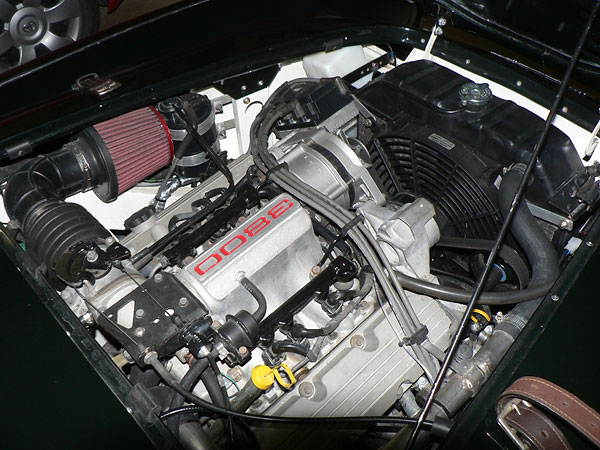
�
Stock Holden 3800 (3.8L) V6, featuring GM electronic fuel injection.
�
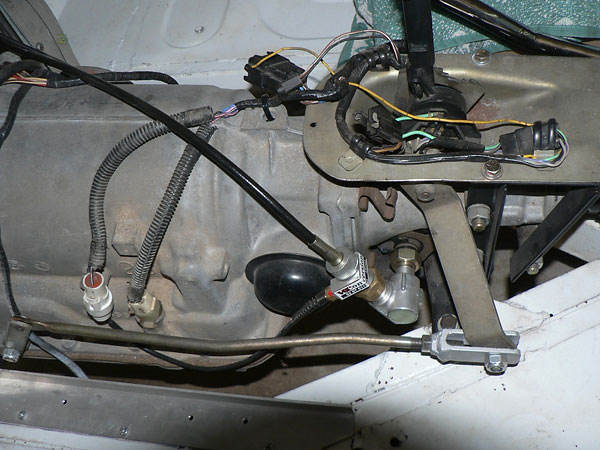
�
Modified shifter on the GM 700/R4 automatic transmission.
�
�
Enjoying this article? Our magazine is funded through the generous support of readers like you!
�
To contribute to our operating budget, please click here and follow the instructions.
�
(Suggested contribution is twenty bucks per year. Feel free to give more!)�
Before Pictures
��
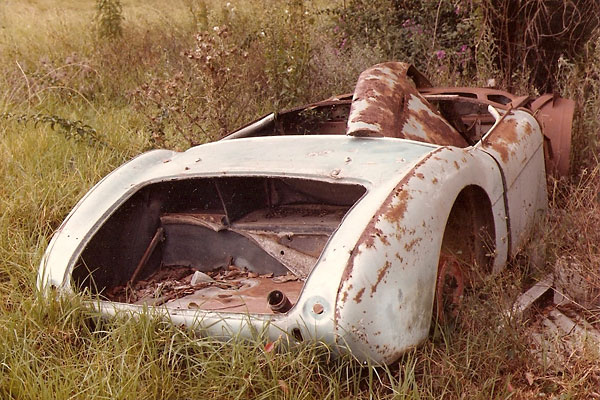
�
The car as found in a paddock in New South Wales by previous owner Bob Whittred.
�
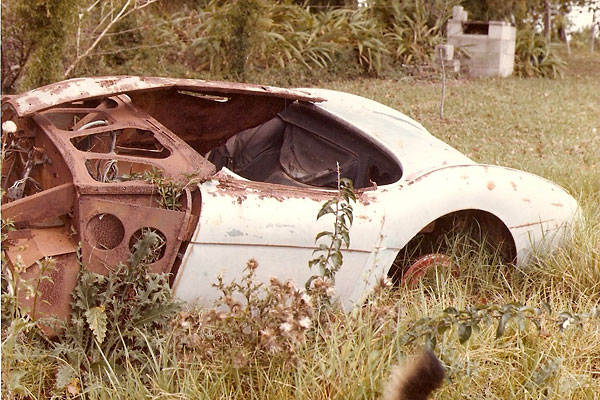
�
It had sat for many years following an apparently fatal accident.
�
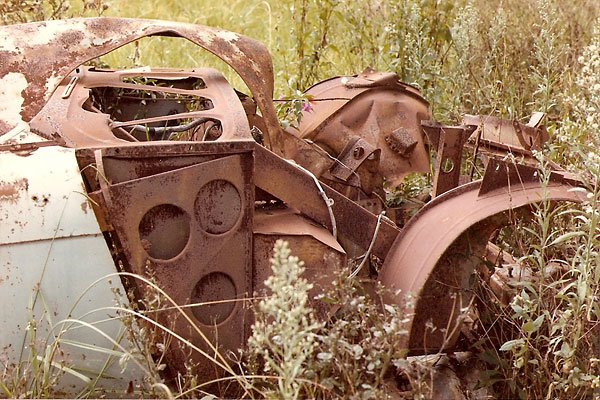
�
The drivetrain and most of the running gear were long gone.
�
�
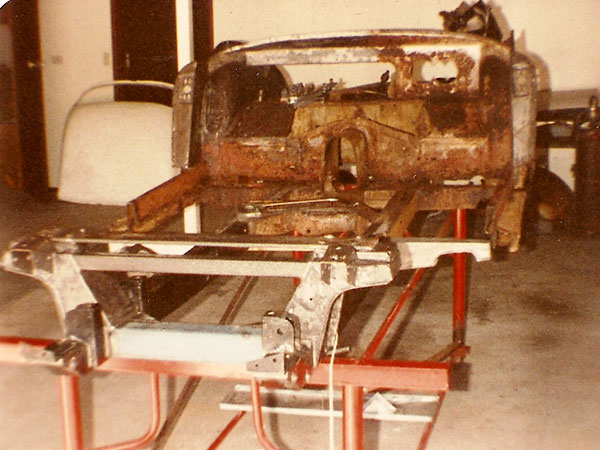
�
Starting into the rust repairs...
�
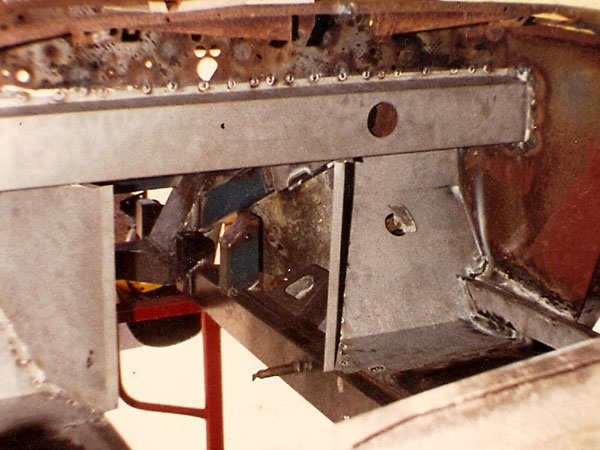
�
Replaced firewall.
�
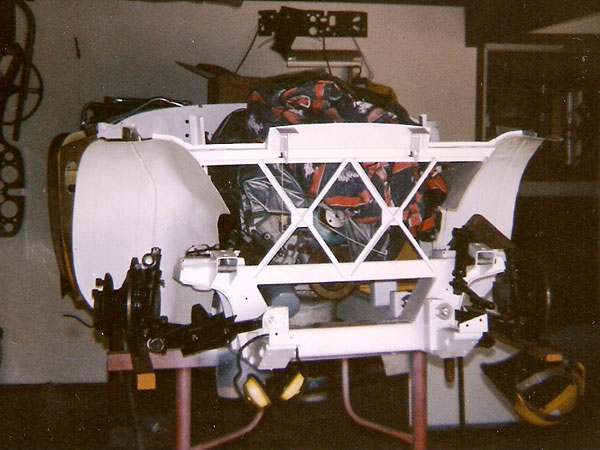
�
Replaced radiator support.
�
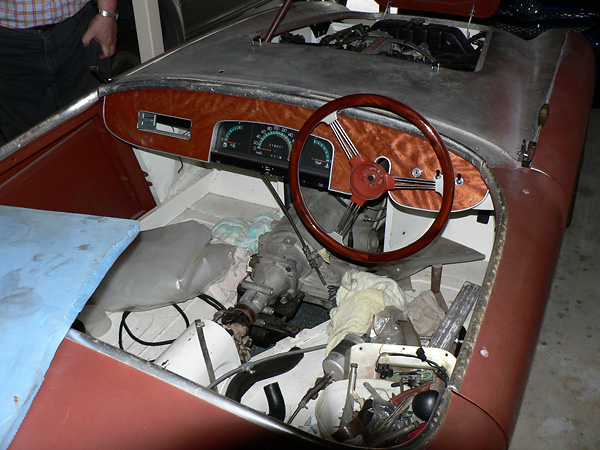
�
A temporary wooden dashboard incorporating the Holden instrument cluster.
�
(This dashboard never saw actual service.)
�
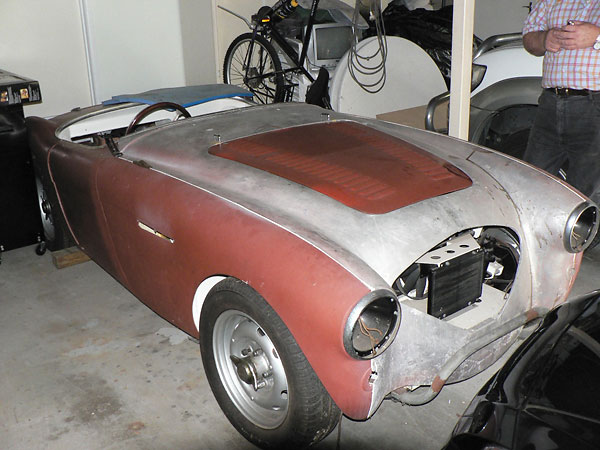
�
Repaired Austin Healey 100 bodywork.
�
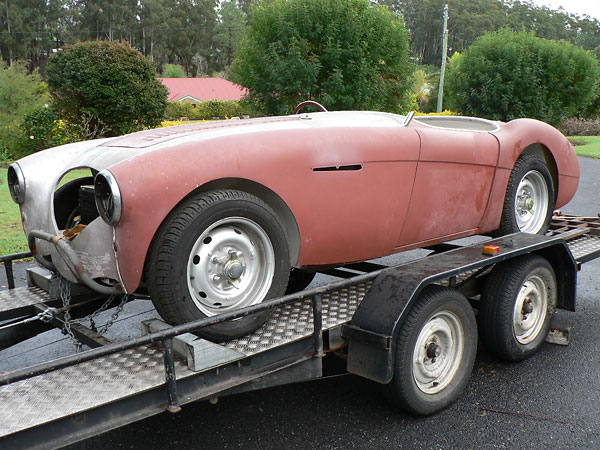
�
Custom bumper bar (awaiting chrome.)
�
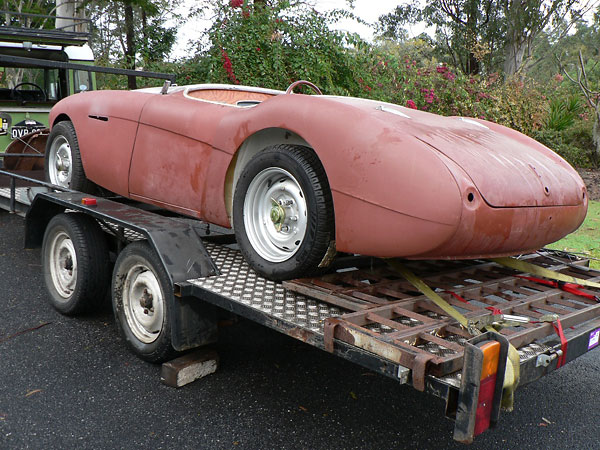
�
Custom fabricated steel wheels comprised of Healey 100/6 wheel centres and Chrysler 5.5" rims.
�
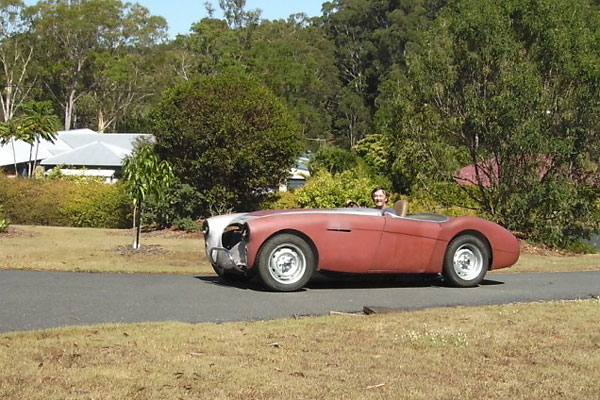
�
Successful test drive!
�
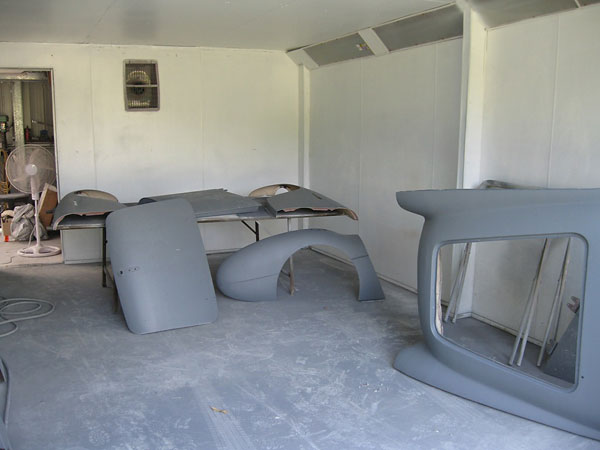
�
Primer.
�
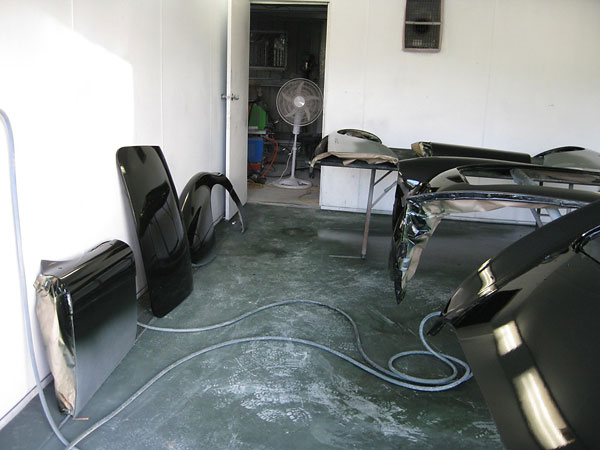
�
Paint.
�
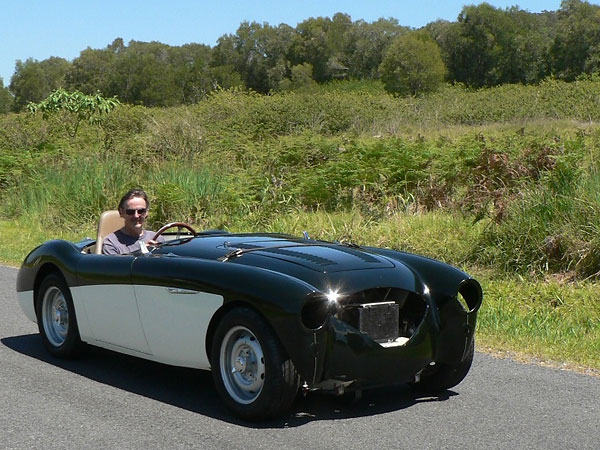
�
Painted: 1950s Jaguar BRG and Old English White.
�
�
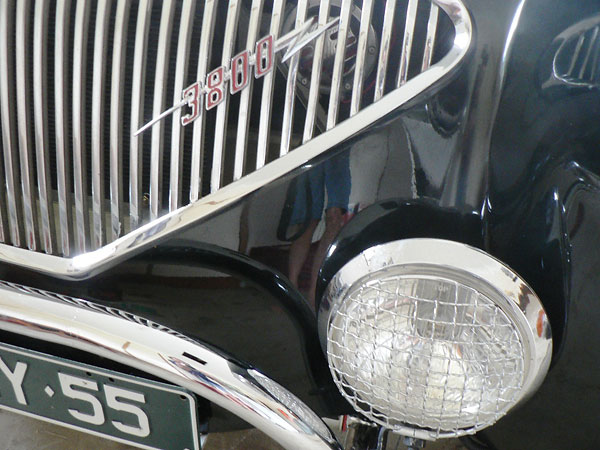
�
Custom "3800" grille emblem.
�
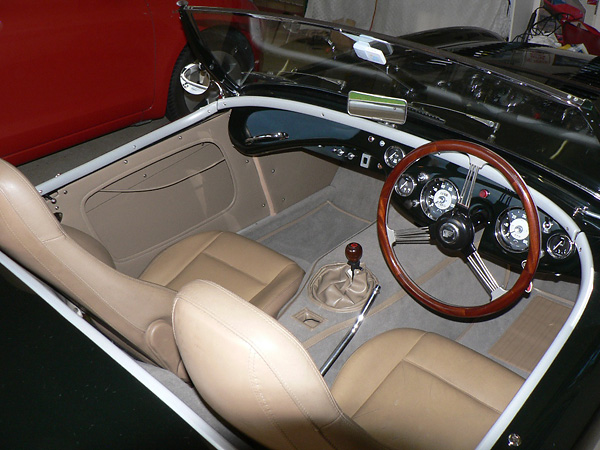
�
Bob Whittred made this custom wood steering wheel. Mazda MX5 (Miata) seats.
�
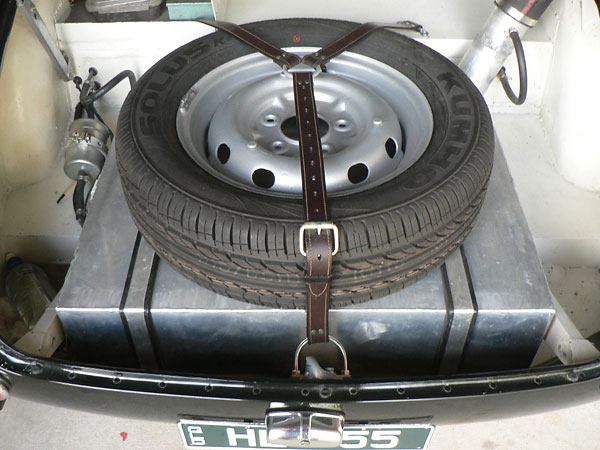
�
Custom fabricated 85 litre aluminum fuel tank.
�
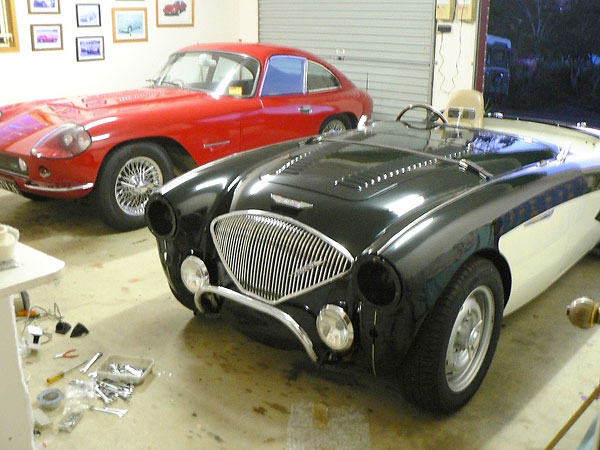
�
The Holden Healey, and its stable mate The Ward Special.
�

